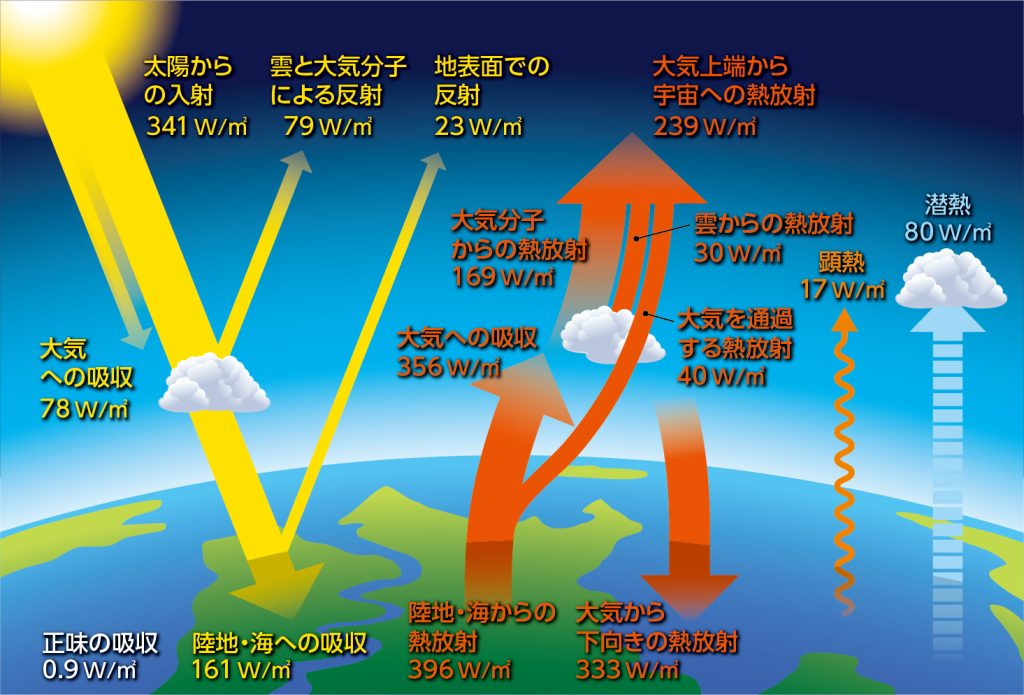2022年7月14日
放射対流平衡
地球のエネルギー収支とは?
「収支」とは、あるシステムに何かがどれだけ出入りして、どれだけがシステムの中に残るかを示すものです。たとえば、家計の収支は家に入って来るお金(収入)と出て行くお金(支出)、そして家に残るお金(貯蓄)について考えます。いっぽう地球のシステムでは、お金の代わりにエネルギーについて考えます。地球のエネルギー収支は太陽から電磁波の放射として受け取るエネルギーと、逆に宇宙に向かって電磁波を放射することで出て行くエネルギーとのバランスを表します。このバランスが崩れると、地球全体の温度や雨の降り方、海の水位などが変化するなどの影響が考えられます。
地球のエネルギー収支のストーリー
太陽から放出されて地球へ降り注ぐ放射エネルギーの一部は、地球の大気を通り抜ける間に雲や小さな粒子に吸収されたり、宇宙へとはね返されたりします(図1)。地球に入ってくるエネルギーのうち地表面にたどり着くのは約55パーセントです。地表面ではエネルギーのほとんどが陸地や海へと吸収されますが、ごく一部は氷や雪など白っぽい色の部分で反射して宇宙へと戻っていきます。

地表面で吸収されたエネルギーもすべてそのまま地中にとどまるわけではありません。地表面の温度が上がり続けないように、エネルギーは熱として宇宙に放射されます。このとき地表面から直接宇宙へと抜けていくのはごく一部で、ほとんどは途中で雲や大気中の二酸化炭素、メタン、水蒸気といった気体に吸収されます。この雲や気体もまた熱を放射していて、宇宙へ向けて出ていくほかに下向きに戻ってきて再び地表を暖める効果があります。これを温室効果と呼びます。
地球全体で大気の上端を通るエネルギーの流れを足し合わせると、実際に太陽から入ってくるエネルギーと地球から放射されるエネルギーの収支は釣り合っていることがわかります。しかし、地表面と大気の中でエネルギーの流れを計算するとそれぞれの部分では釣り合いが取れていません。地表面は太陽から受け取るエネルギーは大気が太陽から受け取るエネルギーよりも多くなっている一方で、大気は熱放射によってエネルギーを失い続けています。つまり地表面と大気の間でエネルギーを再分配するなんらかのプロセスがなければ地表面はどんどん温度が上がり、大気はどんどん温度が下がっていくことになります。放射だけでは地球のエネルギー収支を説明しきれないのです。
ここまでの説明で欠けているのは、暖められる地表面から冷えていく大気へとエネルギーを運ぶプロセスです。水の状態変化に関わるエネルギー(潜熱)と大気の温度変化に関わるエネルギー(顕熱)がこれにあたり、なかでも顕熱に比べて潜熱の効果が大きな割合を占めています。地表面で水が蒸発すると、液体から気体への状態変化に必要な潜熱の分だけ地表面は冷やされ、水蒸気が大気へと出ていきます。その後水蒸気が凝結して雲や雨粒になるとき、今度は潜熱を放出して大気を暖めます。このようにしてエネルギーが上下方向に運ばれることで地球全体のエネルギー収支が保たれています。
放射対流平衡
エネルギー収支が釣り合っていることを平衡状態と呼び、放射対流平衡は上下方向のエネルギーの流れだけを考えて地球のエネルギー収支をシンプルに表現した考え方です。ここでは放射に関するエネルギーの流れと、大気の上昇や下降によって潜熱・顕熱を運ぶ対流に関するエネルギーの流れとの間で釣り合いが取れている状態のことで、気候の研究に広く利用されています。代表的なのは真鍋淑郎博士とRobert Strickler博士による1964年の研究で、地球全体で平均した温度の分布を推定するために放射対流平衡の考え方を使ってシンプルなモデルが作られました。この研究をのちに発展させて得られた結果を模式的に表したのが図2です。放射だけを考えた平衡状態では黒の線で示した現実大気の観測に比べて地表面の温度が高過ぎて上空の温度は低すぎる温度分布になっており、軽いものが下にあり重いものが上にあるという不安定の程度がとても強くなっています。

一方対流を考えに入れた放射対流平衡のモデルの大気では、対流のプロセスがエネルギーを上下方向に分配し直すことでこの不安定な状況が弱まり、放射だけを考えたモデルに比べてより安定で現実大気の観測に近い温度分布になります。このように、地表面を暖め大気を冷やす放射のプロセスと地表面を冷やし大気を暖める対流のプロセスとの間で起こる綱引きのようなやりとりが地球システムの熱力学的な構造を理解するための鍵となります。
What is the Earth’s energy budget?
A budget is a plan that shows how something enters and leaves a system and how much remains in the system. For example, a family budget lists the amount of money coming in (earned), the amount going out (spent), and the amount that remains (savings). In the Earth’s system, instead of money, we think of energy. The Earth’s energy budget describes the balance between the energy that the Earth receives from the Sun and the energy that the Earth radiates back into outer space. An imbalance in the system would cause global temperatures to rise or fall and ultimately change rainfall patterns and sea levels, among other effects.
The Story of Earth’s Energy Budget
Energy enters the Earth’s system from the Sun. Part of the energy emitted by the sun is absorbed or reflected back into space by clouds and particles in the atmosphere as it passes through the atmosphere (Figure 1). Only around 55 percent of the incoming solar energy can make it to the Earth’s surface. Most of the energy is absorbed by the ground or ocean, while a small part of it rebounds at bright ground surfaces such as ice and snow and heads back out into space.
All of the energy the Earth absorbs does not just stay there, otherwise, the surface temperature would keep rising. The Earth radiates this energy out towards space as heat. Only a small portion of the heat emitted from the surface goes directly into space while most of it is absorbed by clouds and certain gases in the atmosphere, such as carbon dioxide, methane, and water vapor. Those clouds and gases also emit energy. Some go outward into space, and some come back to further warm the surface. This is known as the greenhouse effect.
If we sum up all the energy fluxes at the top edge of the Earth’s atmosphere, we can find that the incoming solar energy is indeed balanced by the outgoing heat energy. The energy budget of the whole Earth is in balance. However, the story has not been completed yet. If we check the net flow of energy on the Earth’s surface and in the atmosphere, the energy budget is not balanced. The surface receives more energy from the Sun than the atmosphere does, whereas the atmosphere keeps losing energy through thermal emissions. Without any other processes working to redistribute the energy, the surface will become warmer and warmer, and the atmosphere will become colder and colder. Radiation alone cannot fully explain the Earth’s energy budget.
The missing pieces of the story are the processes that transport energy from the warming surface to the cooling atmosphere. The energy involved in the phase change of water (latent heat) and the energy involved in the change of atmospheric temperature (sensible heat) are two such processes, with the latent heat effect accounting for a larger proportion than the sensible heat effect. When evaporation takes place on the surface, it cools the surface (due to the latent heat required for the phase transition from liquid to gas) and releases water vapor into the atmosphere. Later, when the water vapor condenses back into clouds and rain droplets, the release of latent heat warms the atmosphere. Overall, the energy within the Earth’s system is balanced through the vertical transport.
Radiative-convective equilibrium
An equilibrium state is achieved when energy budget is in balance. The radiative-convective equilibrium (RCE) is like a simple version of the Earth’s system , and only considers heat radiation and vertical heat transport. In RCE, the energy transport by radiation is balanced by the heating related to convection, which transports latent and sensible heats through updraft and downdraft of the air. This simplified system has wide application in climate study. One famous example is the work by Manabe and Strickler in 1964. Based on the concept of radiative-convective equilibrium, they constructed a simple model and used it to simulate the globally average temperature profile. An updated version of Manabe and Strickler’s results is shown in Figure 2. In pure radiative equilibrium, the surface is too warm, and the troposphere is too cold. The atmosphere in this situation is much more unstable than the observation of real atmosphere represented by the black line.
Convection then occurs to release instability and warm the atmosphere. Through the redistribution of energy by convective processes, temperature profile is adjusted to a more stable structure as observed in the Earth. The “tug-of-war” between radiation (trying to warm the surface and cool the troposphere) and convection (cooling the surface and warming the troposphere) is the key to understanding the energy balance and thermodynamic structures of the Earth’s system.
参考文献
Trenberth, K. E., Fasullo, J. T., & Kiehl, J. (2009). Earth’s Global Energy Budget, Bulletin of the American Meteorological Society, 90(3), 311-324.
https://earthobservatory.nasa.gov/features/EnergyBalance/page1.php
https://astrosociety.org/file_download/inline/7963c84d-a909-4794-9cc1-e8a4053b1012
https://brian-rose.github.io/ClimateLaboratoryBook/courseware/rce.html
研究参画者 Ching-Shu Hung
(日本語文作成:神野拓哉)
東京大学 大学院理学系研究科




